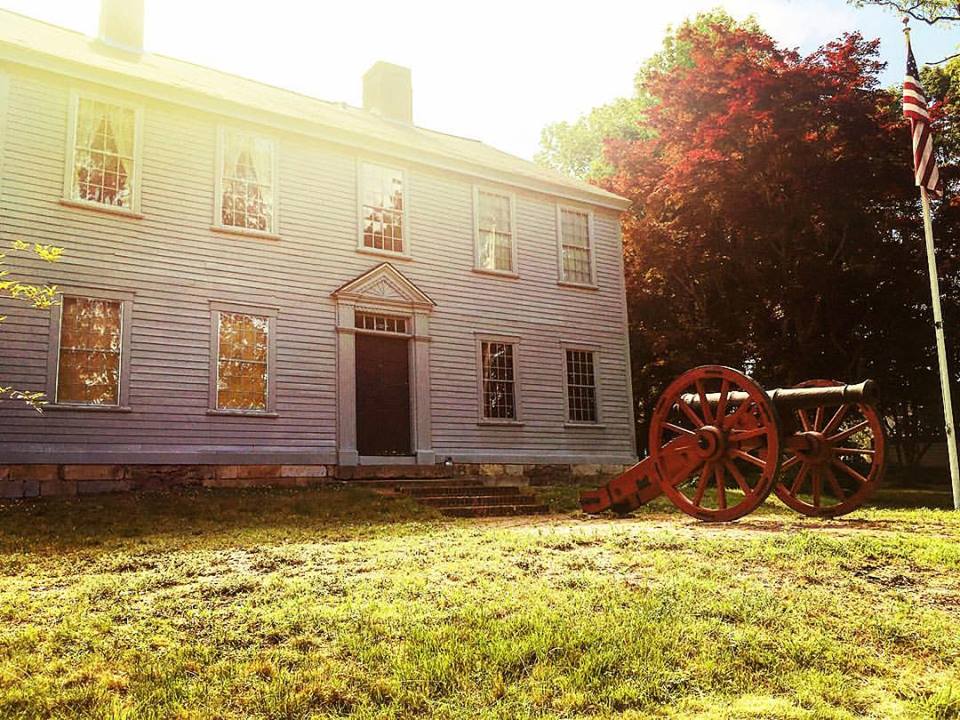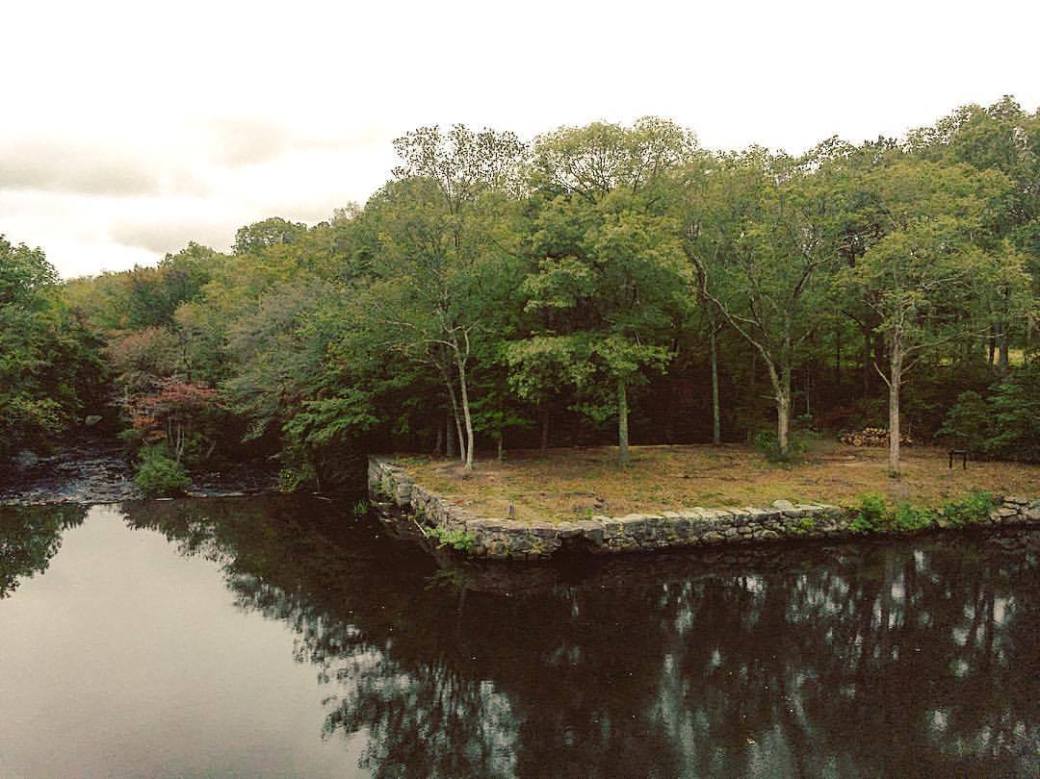I’ve commuted from Providence to Coventry, Rhode Island for work for almost 12 years now. For probably 8 of those 12 years, it’s been with varying frequency on bike. For about 2 of those 8 years, it’s been pretty much always on bike.

For the entire time, I’d been passing signs for the Nathanael Greene Homestead, first on the highway, then on the bike path. I guess technically I’d been passing the signs in some fashion since 1989 when my family moved to Rhode island, but I feel like I get a pass for the earlier years. However, it wasn’t until recently that I decided I should probably see what the place is all about.
For a bit of context, Nathanael Greene was born on August 7, 1742, and his family lived in the area that would eventually become more or less the border of North Kingstown and Warwick, Rhode Island. The farm where they lived included an iron forge that stood along the Potowamut River. The road on which the farm stands today (Forge Road/Old Forge Road) takes it’s name from that forge, although it’s no longer standing.
The house itself is private property, so I’m not showing you pictures of it. But right on the road is a pretty impressive memorial to Nathanael Greene, and it stands next to a sluiceway that, though likely more modern than those of Greene’s time, is still a reminder of what used to exist there.
Greene didn’t spend his entire life there, however, and in 1769 Greene made his way to what’s known today as Coventry (in the 18th century it wasn’t exactly developed) and built what we now call the Nathanael Greene Homestead (also called Spell Hall). He was just 27 years old at the time. It’s located at 50 Taft Street in Coventry, Rhode Island.
Today the Nathanael Greene Homestead is an excellent snapshot of life as it was in the late 18th/early 19th centuries. It’s filled with artifacts that either belonged to Greene or his family, or that were contemporaneous with his time and donated for their historical context.
But beyond the fantastic representation of that slice of history, this place is important because of who Nathanael Greene was. He was a revolutionary war hero. He was a Major General in the Continental Army, second in command to and close friend of George Washington himself. I’ve said before that Spell Hall would have been where George Washington would have dropped by to watch the game on Sundays had that been a thing in the 18th century.
Greene was considered a genius tactician and military strategist, and throughout the Revolutionary War, he engaged in guerrilla tactics against the British. His tactics included strategic retreats, and although the majority of his engagements with the British were considered British victories, they are also often considered strategic victories for the Americans as they crippled British supply lines, caused massive casualties to the point where it didn’t much feel like a victory from the British and, and generally overextended the British troops.
In addition to being second only to George Washington, he is one of only three generals to have served the entire eight years of the Revolutionary War. The other two generals being Henry Knox and (of course) George Washington.
So the Nathanael Greene Homestead is much, much more than a snapshot of life as it would have occurred during the early years of the United States. It’s very much a preservation of the literal founding of the country and its war for independence from Britain.

The front of the Homestead faces away from Taft Street, and overlooks the grounds.
The Homestead itself is presently on 13 acres, although at its peak, the property attributed to it was around 800 acres and included the surrounding areas all the way to the center of Lake Tiogue, a few miles away. Recently and thanks to the efforts of David Procaccini, president the association that owns the Homestead, it received a long term use easement from the nearby Clariant corporation, which sits on land that was originally part of the property.
I recently met with Dave and he graciously not only gave me a tour of the grounds and what work he has done/overseen/has planned, but also let me drop in on a tour of the house. He has truly been working tirelessly and his efforts are showing.
Much of the property has been cleared out for use not only by tours but also for events (earlier this year [2017] saw a Revolutionary War reenactment on the grounds). The work he has done has also cleared out a Greene family cemetery, a 19th century midden, and period roads and foundations. Trails are being opened up and will be marked with colored blazes so that visitors can have an even more immersive experience. Dave has also been very diligent in rebuilding trust with other historical institutions (and funding sources) that was apparently left a bit shaken by previous administrative hijinks (before his time, of course).

A clearing of land on the property was part of an Eagle Scout project. Seen here from a bridge the Washington Secondary Trail (part of the East Coast Greenway), to the immediate left of the picture is Clariant.

Here is the view from the same clearing (before it was cleared) of the bridge from where the above picture was taken.
The Homestead itself is an excellent small museum. The rooms are each set up more or less as they would have been during Greene’s time. Period artifacts range from writing desks, to chests, to magnificent grandfather clocks, beds, silverware, and even outhouses. There are replicas of a Revolutionary War musket and uniform, and even a scarf worn by Nathanael Greene in a portrait that also hangs in one of the rooms.
The architecture itself is an impressive educational experience. A spiral staircase runs up the center of the house and served as roof access to be able to douse a fire from the top of the chimney in the even of an emergency. Closet space is limited and is an example of the peculiar British regulations of the time.
One room, however, is home to the museum’s military artifacts. Primarily of the Revolutionary War, there are some more modern items as well. There are excellent examples of maps and ammunition from the time period. One awesome item is a rather peculiar-looking American flag, called the Guilford Flag or the Guilford Courthouse Flag.
Used as an example both of stylization of the American Flag by individual militias or regiments as well as of lack of standardization during the early years of the United States, the Guilford Flag is a unique part of American history.
However, this is America. And if it’s one thing that Americans have a soft spot for, it’s the American Flag. It represents all of the struggles and feel-goodiness of the American identity, and is as important to the people here as the president of the country is. That said, one of the most incredible things in the collections at the Nathanael Greene Homestead is a fragment of Nathanael Greene’s own American flag–carried by him during the Revolutionary War.


It may not look like much. But this is the real deal. The flag that this fragment was a part of traveled with Greene throughout the Revolutionary War and was likely with him at Valley Forge and during meetings with George Washington. If that isn’t awesome, I don’t know what is.
And it’s sitting in a glass case in a museum in Coventry, Rhode Island. For FIVE DOLLARS you can get a tour of the museum and see this very same flag fragment, as well as all of the other incredible artifacts housed there.
If you live in the area, the Homestead is always looking for volunteers. You can go to their website for more information about their operating hours, as well as events and volunteer opportunities. They’re in the middle of some renovations, and I have it on pretty good authority that they’re going to be looking for help with things like painting and such come spring. You can also follow their Facebook Page for other opportunities, including donation links.
Lastly, and for my fellow cyclists. Turning off the Washington Secondary Trail onto Laurel Ave. and then immediately onto Taft Street, you’re confronted with a short but respectably painful hill that hits 10% grade at its steepest. It ends quickly though, I promise.













A piece of R.I. history that’s been neglected, both in habitat and any tourism item. David and the volunteers have done a wonderful job in restoring this and in recognizing the value of history. R.I. has a rich history of Colonial times yet all we’ve done is tear them down & constructed too many (now empty) buildings that sit as an eyesore on the landscape.
Another Revolutionary building is the Betsy Williams Cottage in Roger Williams Park. Schools brought us on field trips to see how people lived. We pour a ton of money into the Park but I don’t think there’s been any tour in decades.
If you live in America, this is part of your history. It can’t and shouldn’t be ignored. For those born in our technological age, it should open their eyes as to how we got where we are today.
Thank you for the wonderful background and pictures of our place in history.
LikeLiked by 1 person
Thanks so much for your comment! I agree with you completely. There’s so much history in Rhode Island. As one of the original 13 colonies, why wouldn’t there be? But it’s so under appreciated. A big part of Pedal Powered Anthropology is to bring as much of that to light as possible. I’m currently working on a documentary that explores Rhode Island’s role in the Industrial Revolution. If you keep an eye on this blog or the Facebook page (Facebook.com/anthrospin) I hope to he done with it by the end of October.
Thanks again for your commentary, I really appreciate it 😺
LikeLike
Pingback: Rhode Island’s Industrial Revolution – Pedal Powered Anthropology